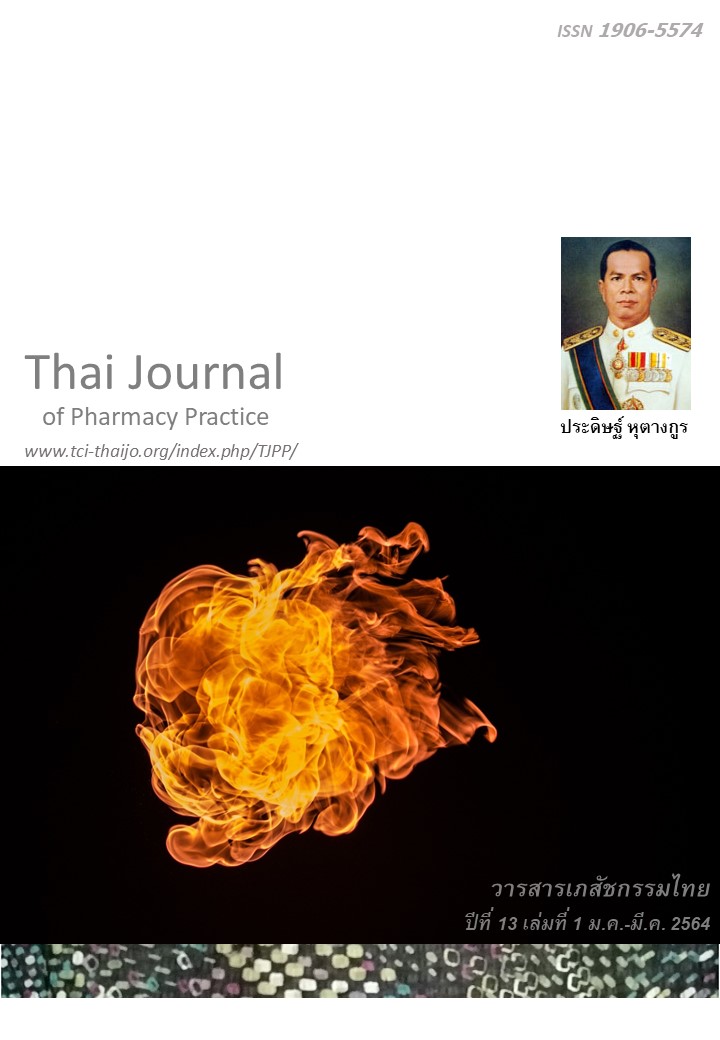การทบทวนวรรณกรรมอย่างเป็นระบบของวิธีตรวจไวรัสในอากาศ เพื่อสร้างวิธีต้นแบบในการตรวจสำหรับสถานพยาบาล
Main Article Content
บทคัดย่อ
วัตถุประสงค์: 1) เพื่อทบทวนวรรณกรรมอย่างเป็นระบบในเรื่องวิธีการตรวจไวรัสในอากาศในสถานพยาบาลจากหลักฐานเชิงประจักษ์ที่มีจากอดีตจนถึงปัจจุบัน และ 2) สร้างวิธีต้นแบบสำหรับตรวจไวรัสในอากาศสำหรับสถานพยาบาลทั่วไป วิธีวิจัย: การศึกษาสืบค้นฐานข้อมูลสิทธิบัตรและอนุสิทธิบัตรทั่วโลก และสืบค้นงานวิจัยที่เกี่ยวข้องจากฐานข้อมูล ได้แก่ PubMed, Cochrane Central Register of Control Trials (CENTRAL), Google Scholar, ScienceDirect, Web of Science, CINALH, Open Grey, DART-Europe ThaiLIS, ThaiJO และ Thai Index Medicus ผลลัพธ์ที่สนใจ คือ วิธีการตรวจไวรัสในอากาศ ผลการวิจัย: ข้อมูลจากการทบทวนวรรณกรรมได้ถูกสังเคราะห์ให้เกิดประเด็นสำคัญและนำมาสร้างวิธีต้นแบบสำหรับตรวจไวรัสในอากาศสำหรับสถานพยาบาลทั่วไป วิธีต้นแบบประกอบด้วย 5 ขั้นตอน ได้แก่ 1) การเตรียมตัวอย่างไวรัสในอากาศ, 2) การเตรียม virus suspension, 3) การย้อมสีอนุภาคไวรัสด้วย fluorescence dye, 4) การล้าง fluorescence dye และ 5) การส่องภายใต้แสงเลเซอร์เพื่อติดตามการเรืองแสงของอนุภาคไวรัส สรุป: การศึกษาครั้งนี้ทำให้ได้วิธีต้นแบบสำหรับตรวจไวรัสในอากาศสำหรับสถานพยาบาลทั่วไป ซึ่งต้องมีการทดสอบในห้องปฏิบัติการและการตรวจวัดในสถานพยาบาลจริงต่อไป
Article Details
ผลการวิจัยและความคิดเห็นที่ปรากฏในบทความถือเป็นความคิดเห็นและอยู่ในความรับผิดชอบของผู้นิพนธ์ มิใช่ความเห็นหรือความรับผิดชอบของกองบรรณาธิการ หรือคณะเภสัชศาสตร์ มหาวิทยาลัยสงขลานครินทร์ ทั้งนี้ไม่รวมความผิดพลาดอันเกิดจากการพิมพ์ บทความที่ได้รับการเผยแพร่โดยวารสารเภสัชกรรมไทยถือเป็นสิทธิ์ของวารสารฯ
References
Centers for Disease Control and Prevention. How to protect yourself & others [online]. 2020 [cited Apr 5, 2020]. Available from: www.cdc.gov/coronavirus/20 19-ncov/prevent-getting-sick/prevention-H.pdf.
Kumar S, Jha S, Rai SK. Significance of super spreader events in COVID-19. Indian J Public Health. 2020 ;64:S139-S141.
Agranovski IE, Safatov AS, Sergeev AA, Pyankov OV, Petrishchenko VA, Mikheev MV, et al. Rapid detection of airborne viruses by personal bioaerosol sampler combined with the PCR device. Atmos Environ 2006; 40: 3924-9.
Takenaka K, Togashi S, Miyake R, Sakaguchi T, Hide M. Airborne virus detection by a sensing system using a disposable integrated impaction device. J Breath Res 2016; 10: 036009.
Booth TF, Kournikakis B, Bastien N, Ho J, Kobasa D, Stadnyk L, et al. Detection of airborne severe acute respiratory syndrome (SARS) coronavirus and envi ronmental contamination in SARS outbreak units. J Infect Dis. 2005; 191: 1472-7.
D'Arcy N, Cloutman-Green E, Klein N, Spratt DA. Environmental viral contamination in a pediatric hospital outpatient waiting area: implications for infection control. Am J infection Control 2014; 42: 856-60.
Verani M, Bigazzi R, Carducci A. Viral contamination of aerosol and surfaces through toilet use in health care and other settings. Am J infection Control 2014; 42: 758-62.
Bonifait L, Charlebois R, Vimont A, Turgeon N, Veillette M, Longtin Y, et al. Detection and quantification of airborne norovirus during out breaks in healthcare facilities. Clin Infect Dis 2015; 61: 299-304.
Nguyen TT, Poh MK, Low J, Kalimuddin S, Thoon KC, Ng WC, et al. Bioaerosol sampling in clinical settings: a promising, noninvasive approach for detecting respiratory viruses. Open Forum Infect Dis 2016; 4: ofw259-ofw.
Wan GH, Huang CG, Chung FF, Lin TY, Tsao KC, Huang YC. Detection of common respiratory viruses and mycoplasma pneumoniae in patient-occupied rooms in pediatric wards. Medicine. 2016; 95: e3014.
Pan M, Bonny TS, Loeb J, Jiang X, Lednicky JA, Eiguren-Fernandez A, et al. Collection of viable aerosolized influenza virus and other respiratory viruses in a student health care center through water-based condensation growth. mSphere. 2017; 2: e00251-17.
Ryu BH, Kim JY, Kim T, Kim MC, Kim MJ, Chong YP, et al. Extensive severe fever with thrombocytopenia syndrome virus contamination in surrounding environment in patient rooms. Clin Microbiol Infect 2018; 24: 911.
Yadana S, Coleman KK, Nguyen TT, Hansen-Estruch C, Kalimuddin S, Thoon KC, et al. Monitoring for airborne respiratory viruses in a general pediatric ward in Singapore. J Public Health Res 2019; 8: 1407.
Faridi S, Niazi S, Sadeghi K, Naddafi K, Yavarian J, Shamsipour M, et al. A field indoor air measurement of SARS-CoV-2 in the patient rooms of the largest hospital in Iran. Sci Total Environ 2020; 725: 138401.
Ong SWX, Tan YK, Chia PY, Lee TH, Ng OT, Wong MSY, et al. Air, surface environmental, and personal protective equipment contamination by severe acute respiratory syndrome coronavirus 2 (SARS-CoV-2) from a symptomatic patient. JAMA. 2020; 323: 1610-2.
Shiu EYC, Huang W, Ye D, Xie Y, Mo J, Li Y, et al. Frequent recovery of influenza A but not influenza B virus RNA in aerosols in pediatric patient rooms [online]. 2020 [cited May 5, 2020]. Available from:
onlinelibrary.wiley.com/doi/full/10.1111/ina.12669
Takenaka K, Togashi S, Miyake R, editors. Rapid airborne virus detection using mist-labeling based on micro reaction process. [online] 2012 [cited Apr 5, 2020]. Available from: www.rsc.org/images/loc/ 2012/pdf/W.7.156.pdf
Pyankov OV, Pyankova OG, Agranovski IE. Inactivation of airborne influenza virus in the ambient air. J Aerosol Sci 2012; 53: 21-8.
Usachev EV, Usacheva OV, Agranovski IE. Surface plasmon resonance-based real-time bioaerosol detection. J Appl Microbiol 2013; 115: 766-73.
Usachev EV, Tam AM, Usacheva OV, Agranovski IE. The sensitivity of surface plasmon resonance based viral aerosol detection. J Aerosol Sci 2014; 76: 39-47.
Usachev EV, Agranovski E, Usacheva OV, Agranov ski IE. Multiplexed surface plasmon resonance based real time viral aerosol detection. J Aerosol Sci 2015; 90: 136-43.
Ladhani L, Pardon G, Meeuws H, van Wesenbeeck L, Schmidt K, Stuyver L, et al. Sampling and detection of airborne influenza virus towards point-of-care applications. Plos One. 2017; 12: e01743 14.
Yu H, Afshar-Mohajer N, Theodore AD, Lednicky JA, Fan ZH, Wu CY. An efficient virus aerosol sampler enabled by adiabatic expansion. J Aerosol Sci. 2018; 117: 74-84.
Moloney M, Shreffler WG. Basic science for the practicing physician: flow cytometry and cell sorting. Ann Allergy Asthma Immunol 2008; 101: 544-9.
Goyal SM, Anantharaman S, Ramakrishnan MA, Sajja S, Kim SW, Stanley NJ, et al. Detection of viruses in used ventilation filters from two large public buildings. Am J Infect Control 2011; 39: e30-8.
Sigmaaldrich. Technical bulletin PKH67 [online] 2012 [cited Apr 5, 2020]. Available from: www.sigmaaldrich.com/content/dam/sigma-aldrich/ docs/Sigma/Bulletin/pkh67glbul.pdf.
Irwin CK, Yoon KJ, Wang C, Hoff SJ, Zimmerman JJ, Denagamage T, et al. Using the systematic review methodology to evaluate factors that influence the persistence of influenza virus in environmental matrices. Appl Environ Microbiol. 2011; 77: 1049-1060. doi:10.1128/AEM.02733-09
Sookchaiya T, Monyakul V, Thepa S. Assessment of the thermal environment effects on human comfort and health for the development of novel air conditioning system in tropical regions. Energy Build 2010; 42: 1692-702
Chia PY, Coleman KK, Tan YK, Ong SWX, Gum M, Lau SK, et al. Detection of air and surface contamination by SARS-CoV-2 in hospital rooms of infected patients. Nat Commun. 2020; 11: 2800.
Coronavirus COVID-19 (SARS-CoV-2) detection, characterization, vaccine and therapy production [online]. 2020 [cited Apr 5, 2020]. Available from: www.sigmaaldrich.com/covid-19.html
Xie D. Fluorescent dye labeled influenza virus mainly infects innate immune cells and activated lymphocytes and can be used in cell-mediated immune response assay. J Immunol Methods. 2009; 343: 42-8.

